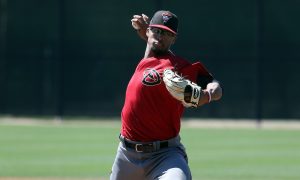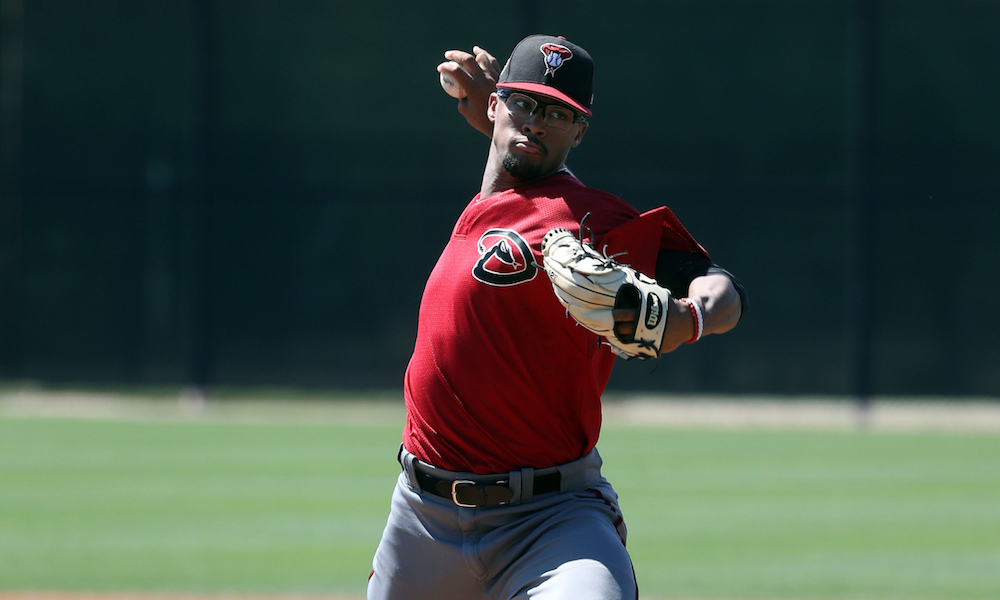Featured Photo: Jon Duplantier, RHP, Diamondbacks
 It’s tough for Class A starting pitchers to stand out beyond their sphere and generate significant press, but Arizona Diamondbacks’ pitching prospect Jon Duplantier caught plenty of attention for the first half that he put together for the Kane County Cougars in the Midwest League this season. The 6-foot-4, 225-pound right-hander didn’t allow an earned run over his first four starts of the season, and as a result, his May 2 start in which he threw five innings and finally allowed three earned runs inspired David Laurila of Fangraphs to note the occasion. Then, after the general baseball populace stopped paying attention, Duplantier went on another run, throwing five more consecutive starts covering 29 innings pitched without allowing a run, a streak that came to an end on June 3 in an outing against Quad Cities, though he worked into the seventh inning and still earned the win in a 5-2 contest versus the Quad Cities River Bandits. In all, Duplantier threw 51 1/3 scoreless innings, separated only by the runs allowed in his May 2 start.
It’s tough for Class A starting pitchers to stand out beyond their sphere and generate significant press, but Arizona Diamondbacks’ pitching prospect Jon Duplantier caught plenty of attention for the first half that he put together for the Kane County Cougars in the Midwest League this season. The 6-foot-4, 225-pound right-hander didn’t allow an earned run over his first four starts of the season, and as a result, his May 2 start in which he threw five innings and finally allowed three earned runs inspired David Laurila of Fangraphs to note the occasion. Then, after the general baseball populace stopped paying attention, Duplantier went on another run, throwing five more consecutive starts covering 29 innings pitched without allowing a run, a streak that came to an end on June 3 in an outing against Quad Cities, though he worked into the seventh inning and still earned the win in a 5-2 contest versus the Quad Cities River Bandits. In all, Duplantier threw 51 1/3 scoreless innings, separated only by the runs allowed in his May 2 start.
After posting a 1.24 ERA and striking out 78 in 72 2/3 innings for the Cougars, Duplantier was promoted to the High A Visalia Rawhide of the California League on June 22. Duplantier’s success has continued in the hitter-friendly Cal League, where he has a 2.35 ERA through his first two starts, and his 2017 performance to-date earned him a spot on the Team USA roster in yesterday’s 2017 SiriusXM All-Star Futures Game.
 Duplantier credits two things for his early success this season: his mental approach on the mound, and a curveball he picked up while at Rice University (Houston, TX).
Duplantier credits two things for his early success this season: his mental approach on the mound, and a curveball he picked up while at Rice University (Houston, TX).
The mental approach comes from the rare opportunity that Duplantier had to live overseas at two different points in his formative years, spending about a year and a half living in Dubai in 1999, and then another 18 months in Jakarta, Indonesia, in 2005. In both cases, the Duplantiers moved overseas because of his father’s job at ConocoPhillips, the job that brought his family from Newark, Delaware, where he was born, to Katy, Texas, where he spent the bulk of his childhood.
“Especially in Jakarta, my mind was malleable, and so while I was over there, I wasn’t necessarily an athlete [to them],” Duplantier shared during a May 12 interview. “I was one of the better athletes over there, but they didn’t see me as an athlete. When you meet somebody over there, they get to your core a little differently. There are different things that are important to them, so you learn to perceive things differently.”
For Duplantier, his time in Indonesia has benefitted him both on the mound and off of it. On the mound, he is unflappable but vicious when he needs to be. He thrives on the calm that characterizes his starts, but he has learned to challenge the nervous energy that comes with his turn in the rotation and use it to his advantage.
“Before a start, I was always antsy,” Duplantier said. “I would get up at 4:45 am in college and eat two breakfasts just because I had all this energy.”
Now, he prefers fishing with his host family, and although he experimented with listening to gospel music during his pregame routine because it made him feel calm before a start, he has since switched that up.
“It made me feel good, but I was too nice,” Duplantier said. “I couldn’t flip the switch.”
So instead, Duplantier typically chooses Kanye West’s “Graduation” album to get him ready to take the mound, and it is a change that has contributed to opposing hitters finding him far from nice, at least in terms of trying to get a hit off of him.
Off the field, Duplantier is more like the gospel music he listens to: calming, gracious, and open. Much of this he credits to his time overseas, citing how it changed the way he interacts with other people and has made him more open minded.
“Being back over here, I’ve tried to keep what I learned overseas at my core. I know it’s cliche, but things like not judging a book by its cover and taking things with a grain of salt,” Duplantier said. “You will always hear rumors, things about other people, and I feel like my experiences overseas helped with how I evaluate people.”
The value of a positive and relaxed clubhouse culture is difficult to quantify, but Duplantier notes the atmosphere in Diamondbacks’ organization overall, and the Kane County clubhouse specifically, as a part of the reason why his first full season in professional baseball got off to such a good start.
“It’s not like I get on the mound to get away from anything right now. Life is pretty stress free. They don’t make me feel like I have to prove myself to anybody,” Duplantier said. “Which a lot of people would assume that’s what this year is all about: proving I can pitch, proving I can get people out without just a curveball, proving I can throw strikes. It’s not about proving; it’s just go out there and do what you do.”

Jon Duplantier (RHP, Diamondbacks) on the mound during 2017 spring training.
Duplantier says that being given the freedom to explore what mechanical tweaks work best for him has given him some added confidence, and the freedom to decide how to use his arsenal to attack hitters is a big part of why he was able to earn a promotion to High A in his first year of professional baseball.
“They give you the information and let you decide, and that environment translates into a sense of calm on the mound,” Duplantier said.
Duplantier’s demeanor has been only one aspect of why he has been so successful. His curveball has been another key factor, and it’s become his best pitch. He picked it up at Rice University after he suffered from a shoulder impingement early in his college career.
Wayne Graham, the head baseball coach at Rice since 1992, said that the knuckle curve, or “spike” curve, as it is sometimes called, is a pitch commonly taught in his program when a pitcher comes in without a power curveball, but in Duplantier’s case, it was also protective move for his arm.
“The slider for some people creates problems, so we teach the spike curveball,” Graham said. “You can throw it harder, and you keep more of your hand behind the ball, you can get the ball over your middle finger without twisting your arm as much. Your wrist stays behind the ball because the spike stabilizes the grip to stay behind the ball to allow you to stabilize instead of ‘flopping.’”
Duplantier tinkered with the curveball prior to being shut down for the 2015 season with the shoulder issue and then picked it up in earnest when he returned in 2016.
“It’s hard not to be exposed to it here,” Graham said. “We have a good feeling for why it works and why you can command it more than the power curve. It has vicious tilt, it’s a roll-off-the-table curve.”
It would be some time before Duplantier could put that knuckle curve to use in a game situation in college, however. He was shut down with the shoulder issue in 2015 when he felt problems with his shoulder very early in the preseason.
“I threw in the first intrasquad of our [2016] spring season, and when I woke up, I couldn’t wash my hair. During the scrimmage, I threw a pitch and in between I couldn’t feel my arm; it was just radiating pain. Every pitch I threw felt fine, but afterward, it did not feel good,” Duplantier said. “It gradually got more tense and tense until I couldn’t wash my hair the next day.”
The problem was a shoulder impingement that built up over time because his shoulder muscles stopped working to elevate his scapula, or shoulder blade, and as a result, his acromion — the part of the scapula that connects to the shoulder — was making contact with the shoulder joint in a way that caused inflammation. Once Duplantier tweaked his delivery to elevate his scapula, he said the inflammation went down and everything smoothed out from there. He has not had shoulder problems since, and Duplantier was even ready to return in a relief role in May 2015, but he declined, saying that he didn’t want at the time to spoil the chances his teammates had earned to take the ball in high-leverage innings late in the season.
“I didn’t want to come in and take that from one of the guys who had earned the right to pitch in that late inning,” Duplantier said.
Duplantier returned in 2016 to start for Rice, going 7-7 in 16 starts with a 3.24 ERA, which was good enough for the Diamondbacks to select him in the third round (#89 overall) in that year’s MLB Draft. The Diamondbacks were careful with Duplantier in his first professional season, and he threw only one inning with the Short-Season A Hillsboro Hops last season I the Northwest League. Now two years removed from the shoulder issues, Duplantier has his entire arsenal available at his disposal, and he’s putting it to work.
As a professional pitcher, Duplantier expressed the most confidence in his curveball, saying it is the pitch he knows he can throw at any time to get a strike. Duplantier has several other weapons besides the curveball: he throws both a four-seam and a two-seam fastball, as well as a slider that is most effective when running away from right-handed hitters and a changeup to work away from lefties. Duplantier generally lives in the bottom of the zone, throwing his curveball as his put-away pitch when he needs it, and his GO:AO ratio of 1.56 at Kane County shows that hitters are having a tough time squaring up the bottom half of the ball. He is generating his share of swing and miss (5.20 SO:BB ratio) as well, and limiting contact, allowing just 5.6 H/9 prior to his promotion. Having seen him pitch in person in both April and May of this season, Duplantier’s prowess with keeping the ball down in the zone and keeping hitters off balance severely limited their ability to square up the ball and make quality contact.
With the shutdown first half to his 2017 season under his belt, Duplantier is quickly moving up the Diamondbacks’ list of top prospects. If he continues to find success with his four-pitch mix against more advanced bats, the steady Texan could work his way into the Diamondbacks’ rotation as early as 2019, with a realistic role of a number three or number four starter.


